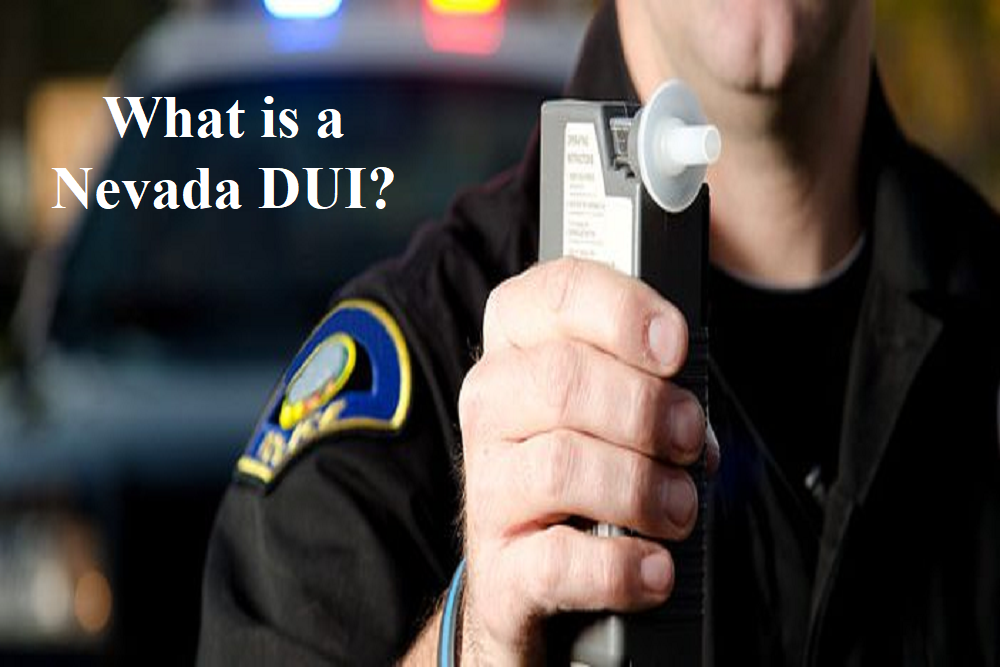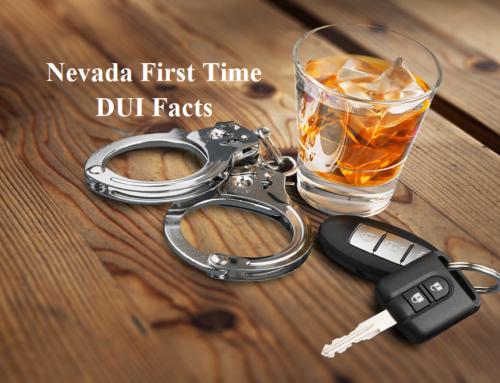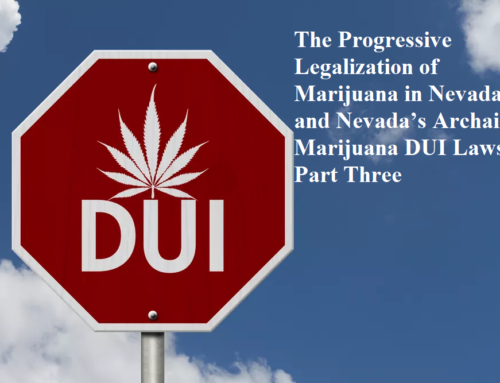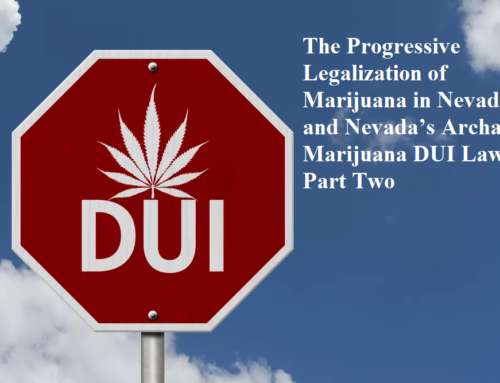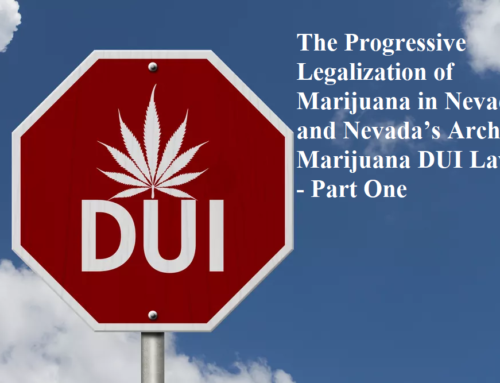“DUI,” known in other States as DWI, OUI or OWI, is obviously an acronym for “driving under the influence.” In Nevada, DUIs are criminal offenses (in some states, e.g., New Jersey, DUIs or DWIs as they are known in New Jersey, are considered traffic offenses, not criminal offenses). Many of my prospective clients believe that “driving under the influence” simply means driving with a specific level of alcohol in their system. While the foregoing description of DUI in Nevada is accurate, it is incomplete.
In Nevada, there are three different ways that the prosecution can charge and convict an individual with DUI: (1) per se or “legal limit” DUI; (2) impairment theory DUI; and/or (3) per se (within two hours) DUI (alcohol only). Nevada’s DUI laws contemplate any and all substances that can cause impairment. You can be convicted of DUI if you are under the influence of any substance ranging from wine coolers to huffing glue. However, the prosecution theories are not the same for all substances. Nevada has per se or “legal limit” laws for alcohol and all “street drugs” (cocaine, heroin, crystal meth, acid, PCP, etc.). But, there are no per se laws for DUIs involving “controlled substances” or prescription drugs. Moreover, effective July 1, 2021, Nevada no longer has per se laws for marijuana DUIs. This means that marijuana and prescription drug DUIs must be prosecuted under Nevada’s impairment theory. Each of Nevada’s three prosecution theories for DUI are discussed in greater detail below.
Per Se (Alcohol) DUI
Nevada’s per se (alcohol) DUI law provides as follows:
[i]t is unlawful for any person who . . . [h]as a concentration of alcohol of 0.08 or more in his or her blood or breath . . . to drive or be in actual physical control of a vehicle on a highway or on premises to which the public has access.
Most people are surprised to learn that the foregoing prosecution theory, or “b” theory as I like to call it, is the least common way that DUI defendants are prosecuted in Nevada. The reason is simple. “B” theory prosecutions require the prosecution to prove the defendant’s alcohol content while he or she was driving or in actual physical control of their vehicle. These prosecutions are rare because there is no officer or nurse sitting in the driver’s seat to administer a breath test or perform a blood draw while the defendant is actually driving his vehicle. Breath tests and blood draws typically occur over an hour after the defendant is removed from their vehicle and transported to the detention center.
Per Se (Street Drugs) DUI
Nevada’s per se (drugs) DUI law provides as follows:
[i]t is unlawful for any person to drive or be in actual physical control of a vehicle on a highway or on premises to which the public has access with an amount of any of the following prohibited substances in his or her blood or urine that is equal to or greater than:
Urine Blood
Nanograms Nanograms
Prohibited substance per milliliter per milliliter
(a) Amphetamine 500 100
(b) Cocaine 150 50
(c) Cocaine metabolite 150 50
(d) Heroin 2,000 50
(e) Heroin metabolite:
(1) Morphine 2,000 50
(2) 6-monoacetyl morphine 10 10
(f) Lysergic acid diethylamide 25 10
(g) Methamphetamine 500 100
(h) Phencyclidine 25 10
The foregoing law sets forth per se or “legal limit” DUI levels for both urine and blood for the most popular “prohibited substances” or street drugs. Although it is overlooked by many prosecutors, the per se (street drugs) DUI law has the same proof issues as the per se (alcohol) DUI law, i.e., the prosecution must prove the defendant’s drug content while the person was driving or in actual physical control of their vehicle.
Per Se (Within 2 Hours – Alcohol) DUI
Nevada’s per se (within 2 hours – alcohol) DUI law provides as follows:
[i]It is unlawful for any person who . . . [i]s found by measurement within 2 hours after driving or being in actual physical control of a vehicle to have a concentration of alcohol of 0.08 or more in his or her blood or breath . . . to drive or be in actual physical control of a vehicle on a highway or on premises to which the public has access.
The foregoing prosecution theory, or “c” theory, is the most common theory that the prosecution will use to prosecute alcohol DUIs in Southern Nevada. This theory will result in a per se DUI conviction (predicated upon proof of an alcohol level of 0.08 or higher) if the prosecution can simply prove that the defendant’s blood draw or breath test was performed within two hours of the defendant’s driving or actual physical control of the vehicle.
Impairment Theory (alcohol, street drugs and/or prescription drugs) DUI
Nevada’s impairment theory DUI laws provide as follows:
[i]t is unlawful for any person who . . . [i]s under the influence of intoxicating liquor . . . to drive or be in actual physical control of a vehicle on a highway or on premises to which the public has access.
[i]t is unlawful for any person who . . .
[i]s under the influence of a controlled substance.
[i]s under the combined influence of intoxicating liquor and a controlled substance; or,
[i]nhales, ingests, applies, or otherwise uses any chemical, poison or organic solvent, or any compound or combination of any of these, to a degree which renders the person incapable of safely driving or exercising actual physical control of a vehicle . . . to drive or be in actual physical control of a vehicle on a highway or on premises to which the public has access.
Nevada statutory law expressly provides that “under the influence” “means impaired to a degree that renders a person incapable of safely driving or exercising actual physical control of a vehicle.” Impairment theory DUIs require no science or forensic analysis. You do not need a reported alcohol or drug level to convict. The prosecution must prove that the defendant was “impaired to a degree that render[ed] [him] incapable of safely driving or exercising actual physical control of a vehicle.” Although toxicology reports evidencing substance levels below the per se statutory levels can be introduced into evidence, impairment theory DUIs are generally proved with non-forensic evidence (driving maneuvers, performance on field sobriety tests, evidence of alcohol consumption (odor of alcohol, admissions of consumption), evidence of physical and cognitive impairment (balance issues, slurred speech, inability to answer simple questions, cognitive deficiencies, etc.) Although not as common as per se (within 2 hours) DUIs, impairment theory DUIs are certainly the second most common DUI prosecution theory in Nevada.
Impairment Theory (marijuana) DUI
Effective July 1, 2021, Assembly Bill 400 amended Nevada’s marijuana DUI laws. Prior to July 1, 2021, Nevada had per se DUI levels for both marijuana and marijuana metabolite just like the street drugs discussed above. Given Nevada’s legalization of the recreational use of marijuana, although it did so very slowly, it was ultimately necessary for the Nevada legislature to amend Nevada’s marijuana DUI laws. Effective July 1, 2021, the prosecution must prove actual impairment for a misdemeanor marijuana DUI. This means there is no per se DUI law for misdemeanor marijuana DUI. However, if the charged marijuana DUI is a felony (third offense within 7 years), the amended law does provide a per se conviction theory. The per se levels for a felony (marijuana) conviction are as follows:
Blood
Nanograms
Substance per milliliter
(a) Marijuana (delta–9–tetrahydrocannabinol) 2
(b) Marijuana metabolite (11–OH-tetrahydrocannabinol) 5
As set forth in recent blogs, the forgoing THC levels have zero scientific correlation to impairment.
What To Do After Getting a DUI
It is important to know the actual DUI laws in your state if you are facing these serious charges. DUI penalties can be severe and stay with a person for a lifetime if not taken seriously. Nevada DUI laws are unique in many ways. If you have been arrested for a DUI in Nevada, you should contact our DUI lawyer today to help fight for your rights. If you have any questions about your DUI offense or the specific theory under which you will be prosecuted, please contact our office to schedule a free and confidential consultation. The attorneys at HAYES WAKAYAMA promise you will meet with an experienced Nevada DUI attorney to discuss your case.

